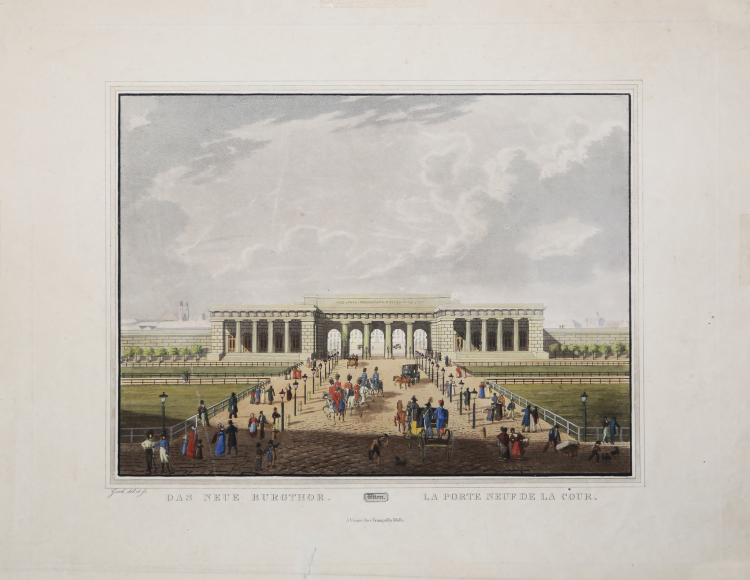



| Reference: | MS5009 |
| Author | Tranquillo MOLLO |
| Year: | 1815 ca. |
| Zone: | Wien |
| Printed: | Wien |
| Measures: | 365 x 290 mm |


| Reference: | MS5009 |
| Author | Tranquillo MOLLO |
| Year: | 1815 ca. |
| Zone: | Wien |
| Printed: | Wien |
| Measures: | 365 x 290 mm |
Egraved plate by Edward Gurck taken from Wien's vorzüglichste Gebäude und Monumente. Les Principaux Batiments et Monuments de Vienne.Vienna: chez Tranquillo Mollo. A set of 79 views of Wien by Josef Leitz and others after Edward Gurck and others.
Tranquillo Maria Laurentio Mollo was a Swiss-born Italian graphic artist and printer, art and music dealer, and important art publisher in Vienna.
Mollo initially worked as an assistant in the music publishing house "Artaria & Co." in Vienna from 1792, but became a partner in Artaria's business with compatriot Giovanni Cappi as early as 1793. Mollo separated from Artaria and founded his own music publishing house "T. Mollo & Co." together with Franz Bernardini in the house "Am Hof No. 346", to which an art and map shop was also attached. In 1801, Mollo took on as a new partner Domenico Artaria, the son of Francesco Artaria. In 1802 Carlo Artaria sold his company to Mollo. In 1804 Mollo separated from his partner Domenico Artaria and now called his publishing company only "T. Mollo".
Mollo became one of the most important art publishers and took the lead in Austrian map and globe production. He collaborated with several French and English cartographers. Especially the serial prints of landscape views and traditional costume illustrations by the draftsman and engraver Wilhelm Friedrich Schlotterbeck brought the company high profits. Through his prints, the aquatint technique invented in England spread to German-speaking countries from about 1800.
Copperplate, printed in colour, with margins, perfect condition.
Tranquillo MOLLO (Bellinzona 1767 - 1837)
|
Tranquillo Maria Laurentio Mollo (* August 10, 1767 in Bellinzona; † March 29, 1837) was a Swiss-born Italian graphic artist and printer, art and music dealer, and important art publisher in Vienna.
Mollo initially worked as an assistant in the music publishing house "Artaria & Co." in Vienna from 1792, but became a partner in Artaria's business with compatriot Giovanni Cappi as early as 1793. The main partners at that time were Carlo Artaria and Francesco Artaria. On July 14, 1798, Mollo separated from Artaria and founded his own music publishing house "T. Mollo & Co." together with Franz Bernardini in the house "Am Hof No. 346", to which an art and map shop was also attached. His partner share in Artaria was paid to him in publishing articles. But the collaboration with Bernardini lasted only a year.
In 1801, Mollo took on as a new partner Domenico Artaria, the son of Francesco Artaria. In 1802 Carlo Artaria sold his company to Mollo. In 1804 Mollo separated from his partner Domenico Artaria and now called his publishing company only "T. Mollo".
Mollo became one of the most important art publishers and took the lead in Austrian map and globe production. He collaborated with several French and English cartographers. Especially the serial prints of landscape views and traditional costume illustrations by the draftsman and engraver Wilhelm Friedrich Schlotterbeck brought the company high profits. Through his prints, the aquatint technique invented in England spread to German-speaking countries from about 1800. As a music publisher, he also published some of Ludwig van Beethoven's works, among others.
From 1832 to 1839 the company was continued by his sons Eduard (1799-1842) and Florian Mollo (1803-1869) as "Kunst- und Musikalienhandlung Tranquillo Mollo's Söhne". After the death of their father, however, the sons separated and ran their own companies.
|
Tranquillo MOLLO (Bellinzona 1767 - 1837)
|
Tranquillo Maria Laurentio Mollo (* August 10, 1767 in Bellinzona; † March 29, 1837) was a Swiss-born Italian graphic artist and printer, art and music dealer, and important art publisher in Vienna.
Mollo initially worked as an assistant in the music publishing house "Artaria & Co." in Vienna from 1792, but became a partner in Artaria's business with compatriot Giovanni Cappi as early as 1793. The main partners at that time were Carlo Artaria and Francesco Artaria. On July 14, 1798, Mollo separated from Artaria and founded his own music publishing house "T. Mollo & Co." together with Franz Bernardini in the house "Am Hof No. 346", to which an art and map shop was also attached. His partner share in Artaria was paid to him in publishing articles. But the collaboration with Bernardini lasted only a year.
In 1801, Mollo took on as a new partner Domenico Artaria, the son of Francesco Artaria. In 1802 Carlo Artaria sold his company to Mollo. In 1804 Mollo separated from his partner Domenico Artaria and now called his publishing company only "T. Mollo".
Mollo became one of the most important art publishers and took the lead in Austrian map and globe production. He collaborated with several French and English cartographers. Especially the serial prints of landscape views and traditional costume illustrations by the draftsman and engraver Wilhelm Friedrich Schlotterbeck brought the company high profits. Through his prints, the aquatint technique invented in England spread to German-speaking countries from about 1800. As a music publisher, he also published some of Ludwig van Beethoven's works, among others.
From 1832 to 1839 the company was continued by his sons Eduard (1799-1842) and Florian Mollo (1803-1869) as "Kunst- und Musikalienhandlung Tranquillo Mollo's Söhne". After the death of their father, however, the sons separated and ran their own companies.
|